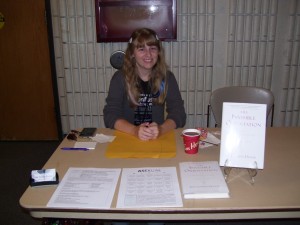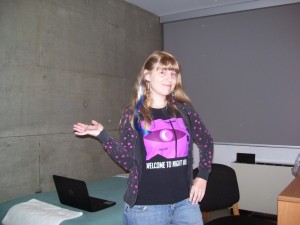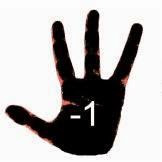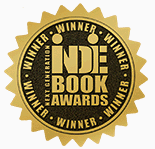In May 2005, after being inspired by some non-traditional text-heavy webcomics, I decided that I too could tell stories in graphic format, and my webcomic Negative One was born.
It was just an experiment for the first month or so; I wanted to see if I could do it, and I knew that webcomic audiences tend to get rabid if artists don’t update on time, so keeping to a set schedule was very important to me. But I settled into it easily and managed to bang out a new issue every Friday for the first month. I can handle this, I thought. And handle it I did.
For the next ten years.
On May 20, 2015, Negative One celebrates ten years of weekly updates, without having ever missed an issue, been late, or gone on hiatus. That’s 522 issues. 11,400 panels. And a lot of busy Fridays. I’m holding a contest to celebrate. There will be three prizewinners, with winners being allowed to pick from comic-related gifts/art or just store credit to any online retailer. Prizes are worth $40, $20, and $10 respectively. And there are multiple ways to enter–taking a quiz, sending me fan art, submitting questions for the characters to answer . . . it’s all in the link!
For the folks who’ve never read my webcomic before, I want to tell you a little about why it’s special and maybe entice you to read it. Since the contest to win prizes is open for over a month, there’s time to read the archives and get caught up if you want to. 😉
Negative One begins as a personal story that alternates between two young women struggling with extraordinary problems. The storytelling involves first-person reflections of their quiet adventures, rendered in light dialogue and heavy introspection, accompanying pencil sketches of the characters. (Yes, pencil sketches. It’s not inked.)
 Chinese-American New Yorker Meri Lin finds herself pregnant unexpectedly, and with her parents disapproving of the baby’s white father, she battles anxiety and growing worries about raising her child. When baby Amanda is born with unheard-of superpowers and Meri Lin’s life mutates into a surreal unknown, she and her devoted partner Fred are on their own dealing with stuff they’ve never heard of outside of science fiction. Her story is about family and fear and all the joys and terrors of mothering a special child, and it also leads to an alternately inspiring and depressing portrayal of how she and Fred handle grief when their worst fears are realized.
Chinese-American New Yorker Meri Lin finds herself pregnant unexpectedly, and with her parents disapproving of the baby’s white father, she battles anxiety and growing worries about raising her child. When baby Amanda is born with unheard-of superpowers and Meri Lin’s life mutates into a surreal unknown, she and her devoted partner Fred are on their own dealing with stuff they’ve never heard of outside of science fiction. Her story is about family and fear and all the joys and terrors of mothering a special child, and it also leads to an alternately inspiring and depressing portrayal of how she and Fred handle grief when their worst fears are realized.
 The other storyline follows Adele, a young woman from another dimension. At the beginning of her tale she is in training to be a master prophet under the tutelage of her teacher Tabitha. She has very mixed feelings about her ultimate mission: her teacher, who is from our world, is sending her there permanently to find and teach the next human with prophetic abilities, but in her journey she’ll lose most of her important memories and never be able to return. She’ll have to live as an alien in a strange world and figure out how to build her life from there, and she’ll have to leave her family and her beloved teacher and most of her identity behind. Adele’s relationship with her teacher and somewhat estranged family, her devotion to her art and her small rebellions, and her eventual travels in our world are at the center of her story.
The other storyline follows Adele, a young woman from another dimension. At the beginning of her tale she is in training to be a master prophet under the tutelage of her teacher Tabitha. She has very mixed feelings about her ultimate mission: her teacher, who is from our world, is sending her there permanently to find and teach the next human with prophetic abilities, but in her journey she’ll lose most of her important memories and never be able to return. She’ll have to live as an alien in a strange world and figure out how to build her life from there, and she’ll have to leave her family and her beloved teacher and most of her identity behind. Adele’s relationship with her teacher and somewhat estranged family, her devotion to her art and her small rebellions, and her eventual travels in our world are at the center of her story.
As the story goes on, I add three more narrators: the first two are male characters from other dimensions who travel to the human world accidentally during a sort of interdimensional earthquake, and the third narrator is Meri Lin’s baby. She starts narrating her own comics when she’s about two years old, and she basically becomes the main/focus character of the webcomic.

To be honest, the comic’s flaws include pretty poor art most of the time and nearly plotless storytelling, with a very slow pace; I know that means it really isn’t for everyone since it’s almost entirely character-oriented and rooted in the everyday existence of extraordinary people who don’t save the world or do anything but battle personal demons and develop/destroy relationships with each other. But I did create the comic for a semi-indulgent reason: I wanted to take the characters from an unpublishable fantasy series I’d written and share them with the world in such a way that I didn’t have to worry about marketability and expectations, and now it’s just a place I can tell the kind of story I want to tell with the characters I care about. So that’s what I’ve done here.
But if you like very nuanced character arcs and want to see explorations of complicated people, you’ll probably find yourself getting invested in the story once you get used to it. Meri Lin and Fred may be raising a child who isn’t like any real baby out in the world, but they also have some relatable struggles: they wrestle with discipline and “me” time and how to cultivate their intimacy despite what they’re facing, and Meri Lin learns to wear a mask to cover her grief, and when family and friends try to help her she has to learn how much to shut out and how much to invite in. Adele deals with being closer to her teacher–a foreigner–than she is to her own mother, and she shoulders crushing responsibility as a very talented prophet who also sometimes needs to make mistakes as a teenage girl. She wonders what kind of love and support can be available to someone like her when she comes to a world where she is a stranger, and when others depend on her for her mystical guidance and perspective, she’s conflicted about what it means to be needed.
My extradimensional characters Weaver and Dax have some complicated struggles too. Weaver has to deal with literal imprisonment at the beginning of his stay in our world, and later there are themes of brotherhood, isolation, and kind of being the local goofy genius. (Seriously, when Meggie showed me Guardians of the Galaxy, Rocket reminded me so much of Weaver.) Dax deals with loyalty and faith/spirituality and the meaning of companionship and strength; he’s kind of a gentle giant type. And he smokes some weed. Heh.
And of course the story follows a ton of complicated stuff as Meri Lin’s baby makes her way into the world. As a very small child whose first understanding of herself incorporates the experience of scaring the crap out of people, she’s at times very fragile and at other times the strongest and most independent child you’ll ever see. She is faced with fitting in and standing out in unprecedented ways, and figuring out how to meet her own needs given some of her ordinary and extraordinary desires makes for some unique opportunities for me as a storyteller.
It may seem like a weird thing to say about a story in which three out of the five narrators aren’t human, but the story also incorporates a lot of diversity and underrepresented perspectives. Obviously all the aliens have that whole Extreme Outsider narrative, but then I do deal with more ordinary marginalization as well. Meri Lin is the daughter of Chinese immigrants (who later moved back to China), and her romantic partner is a white man, so some of her story deals with the unique issues associated with their relationship, and from raising a mixed-race child. As for the baby, when she begins to tell her story, she really has no concept of race, and isn’t frequently recognized as being mixed due to the prominence of other peculiarities, but she is.
The story also features a child from an abusive/neglectful home, a major character who is a black homeless mother who has epilepsy, another mixed-race family with children from different fathers, a white single divorced mother who’s a business owner, and a black man who’s a business owner. A lot of the supporting characters are not white and aren’t necessarily in typical living/working situations. There’s also a secondary character with severe mental impairments who receives support and care from some of the cast members, but she’s also from another dimension. The story is not about characters being Asian or being black or having illnesses, but those aspects of the characters are incorporated into their stories–as part of who they are without being a focal plot point.
I’ve spent ten years bringing little bits of this story to the Internet every Friday, and though I don’t have many loyal readers, I think most of the people still reading are quiet about their enjoyment of it; I don’t get too much interaction or comments. So I figured as part of the ten-year celebration I’d make a few posts about the comic and see if it attracts any new blood. It still gets a little spike of visitors every Friday so I know some people out there are still paying attention, but it would be so cool if some new people dropped by and read one of the things that takes up my time every single week.
Happy anniversary to meeeeeee!
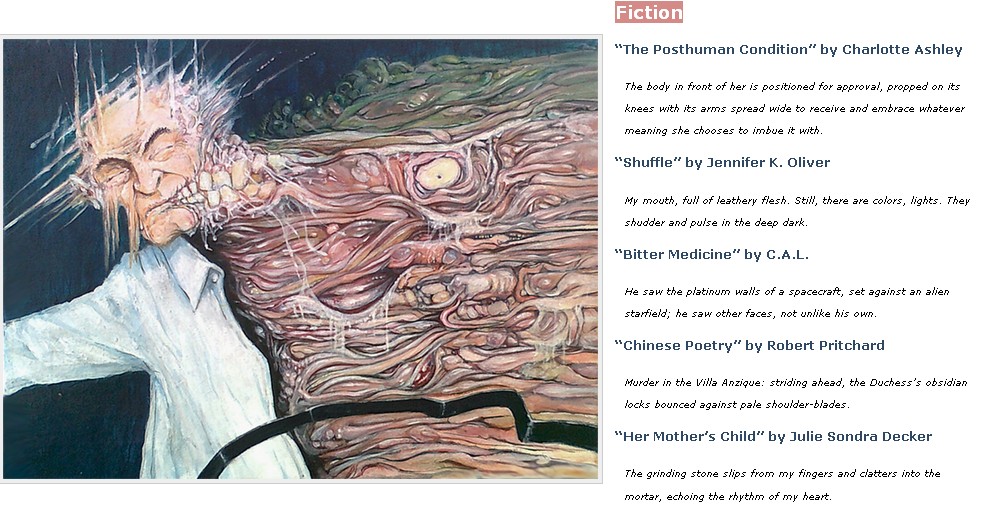 Kaleidotrope publishes mostly speculative fiction and prefers unconventional stories. My story, published in their summer 2015 issue, features a coming-of-age tale in a gently magical secondary-world setting, featuring goddess spirituality, queer perspectives, and a protagonist with an unusual disability.
Kaleidotrope publishes mostly speculative fiction and prefers unconventional stories. My story, published in their summer 2015 issue, features a coming-of-age tale in a gently magical secondary-world setting, featuring goddess spirituality, queer perspectives, and a protagonist with an unusual disability.
